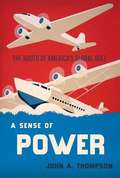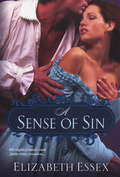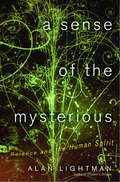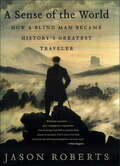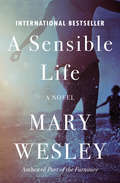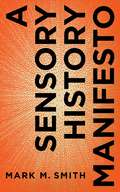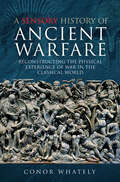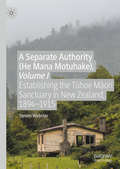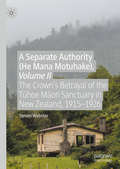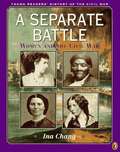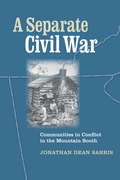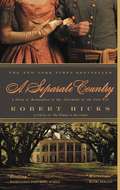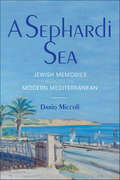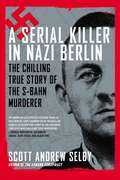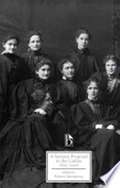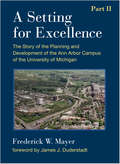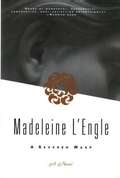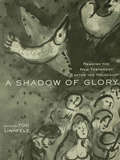- Table View
- List View
A Sense of Power: The Roots of America's World Role
by John A. ThompsonWhy has the United States assumed so extensive and costly a role in world affairs over the last hundred years? The two most common answers to this question are "because it could" and "because it had to." Neither answer will do, according to this challenging re-assessment of the way that America came to assume its global role. The country's vast economic resources gave it the capacity to exercise great influence abroad, but Americans were long reluctant to meet the costs of wielding that power. Neither the country's safety from foreign attack nor its economic well-being required the achievement of ambitious foreign policy objectives. In A Sense of Power, John A. Thompson takes a long view of America's dramatic rise as a world power, from the late nineteenth century into the post-World War II era. How, and more importantly why, has America come to play such a dominant role in world affairs? There is, he argues, no simple answer. Thompson challenges conventional explanations of America's involvement in World War I and World War II, seeing neither the requirements of national security nor economic interests as determining. He shows how American leaders from Wilson to Truman developed an ever more capacious understanding of the national interest, and why by the 1940s most Americans came to support the price tag, in blood and treasure, attached to strenuous efforts to shape the world. The beliefs and emotions that led them to do so reflected distinctive aspects of U.S. culture, not least the strength of ties to Europe. Consciousness of the nation's unique power fostered feelings of responsibility, entitlement, and aspiration among the people and leaders of the United States. This original analysis challenges some widely held beliefs about the determinants of United States foreign policy and will bring new insight to contemporary debates about whether the nation should--or must--play so active a part in world politics.
A Sense of Sin
by Elizabeth EssexHe Could Be Her RuinAfter a shocking letter and then a mysterious warning about the dangers of unworthy men, Celia Burke is on edge. With her precarious position in society, the merest look could tear her reputation to tatters. And the roguish viscount pursuing her seems interested in far more than just a look. . .She Could Be His SalvationRupert Delacorte, Viscount Darling, believes the ravishing Miss Celia Burke played some part in his beloved sister's death. Looking for revenge, he swears he'll seduce and ruin her--without actually touching her. Yet to win Celia's trust and ignite her passions, Delacorte must open his hardened heart to her--and in the process, risk falling for the very woman he hoped to destroy. . .
A Sense of the Heart
by Bill J. LeonardFor many people, knowing about God is not enough; they also want to feel God's presence. Whether like St. Paul's experience on the road to Damascus or like Wesley's "strangely warmed heart," people believe that nothing can substitute for religious experience. Even today, people go to church in order to encounter the Divine, by which they mean experience God in their midst. This desire to meet or be met by God is as old as humanity, but America especially has been the seed bed for what William James famously called "varieties of religious experience." These experiences cover a wide spectrum from classic mysticism to revivalist conversion to a contemporary pursuit of spirituality. A Sense of the Heart traces the nature of religious experience from the colonial era to the present, attempting to define and describe the nature of religious experience and noting common and distinct approaches in the work of various scholars and practitioners. Following that, A Sense of the Heart offers a historical review of representative types of religious experience, the nature of such experiences and their impact on the American religious and cultural context as evident in awakenings, controversies, denominations, and new religious communities.
A Sense of the Mysterious
by Alan LightmanFrom the bestselling author of Einstein's Dreams comes this lyrical and insightful collection of science writing that delves into the mysteries of the scientific process and exposes its beauty and intrigue.In these brilliant essays, Lightman explores the emotional life of science, the power of imagination, the creative moment, and the alternate ways in which scientists and humanists think about the world. Along the way, he provides in-depth portraits of some of the great geniuses of our time, including Albert Einstein, Richard Feynman, Edward Teller, and astronomer Vera Rubin. Thoughtful, beautifully written, and wonderfully original, A Sense of the Mysterious confirms Alan Lightman's unique position at the crossroads of science and art.From the Trade Paperback edition.ly written, A Sense of the Mysterious confirms Alan Lightman's unique position at the crossroads of science and art.From the Hardcover edition.
A Sense of the World: How a Blind Man Became History's Greatest Traveler
by Jason RobertsJason Roberts’s A Sense of the World is a spellbinding and moving rediscovery of one of history's most epic lives, James Holman.National Book Critics Circle Award Finalist“Vastly entertaining, always informative, and often astonishing.” —San Francisco ChronicleHe was known simply as the Blind Traveler—a solitary, sightless adventurer who, astonishingly, fought the slave trade in Africa, survived a frozen captivity in Siberia, hunted rogue elephants in Ceylon, and helped chart the Australian outback. James Holman (1786–1857) became "one of the greatest wonders of the world he so sagaciously explored," triumphing not only over blindness but crippling pain, poverty, and the interference of well-meaning authorities (his greatest feat, a circumnavigation of the globe, had to be launched in secret). Once a celebrity, a bestselling author, and an inspiration to Charles Darwin and Sir Richard Francis Burton, the charismatic, witty Holman outlived his fame, dying in an obscurity that has endured—until now.Drawing on meticulous research, Jason Roberts ushers us into the Blind Traveler's uniquely vivid sensory realm, then sweeps us away on an extraordinary journey across the known world during the Age of Exploration. Rich with suspense, humor, international intrigue, and unforgettable characters, this is a story to awaken our own senses of awe and wonder.“A Sense of the World gives us a man who embraced wanderlust at a time when the continents and oceans were much, much bigger.” —New York Times“An eloquent and sympathetic biography. Roberts’s vibrant prose and meticulous recreation of Holman’s world offer modern readers a chance to see what Holman saw as he tapped his way around the globe.” —Washington Post
A Sensible Life: A Novel
by Mary WesleyThis &“engaging and memorable novel,&” set in post-WWI England and France, takes a wise, witty look at love, growing up, and class differences (Publishers Weekly). For the British families who vacation there, the shore town of Dinard, France, is a getaway from the ills of modern life. But when Flora Trevelyan visits with her self-absorbed parents in 1926, it&’s not an escape she finds—instead, it&’s a doorway into a different world, a different life, that she never knew existed. As the years pass, Flora embarks on a journey of discovery, from falling for three very different young men to understanding the follies of an upper class society of which she will never quite be a part to uncovering the difference between true friends and fair-weather companions. Along the way, her own life and those of her new acquaintances will be upended, and as the shadows of World War II fall over Europe, Flora will have to decide what kind of person she wants to be—and whether being sensible makes sense. Praised by the Daily Telegraph as &“delicious,&” Mary Wesley&’s sharply humorous coming-of-age story weaves a tale of an unloved, neglected child who turns into a fiercely independent woman, both an entertaining romp and an astute glimpse into British society between the two World Wars.
A Sensory History Manifesto (Perspectives on Sensory History #4)
by Mark M. SmithA Sensory History Manifesto is a brief and timely meditation on the state of the field. It invites historians who are unfamiliar with sensory history to adopt some of its insights and practices, and it urges current practitioners to think in new ways about writing histories of the senses.Starting from the premise that the sensorium is a historical formation, Mark M. Smith traces the origins of historical work on the senses long before the emergence of the field now called "sensory history," interrogating, exploring, and in some cases recovering pioneering work on the topic. Smith argues that we are at an important moment in the writing of the history of the senses, and he explains the potential that this field holds for the study of history generally. In addition to highlighting the strengths of current work in sensory history, Smith also identifies some of its shortcomings. If sensory history provides historians of all persuasions, times, and places a useful and incisive way to write about the past, it also challenges current practitioners to think more carefully about the historicity of the senses and the desirability—even the urgency—of engaged and sustained debate among themselves. In this way, A Sensory History Manifesto invites scholars to think about how their field needs to evolve if the real interpretive dividends of sensory history are to be realized.Concise and convincing, A Sensory History Manifesto is a must-read for historians of all specializations.
A Sensory History Manifesto (Perspectives on Sensory History)
by Mark M. SmithA Sensory History Manifesto is a brief and timely meditation on the state of the field. It invites historians who are unfamiliar with sensory history to adopt some of its insights and practices, and it urges current practitioners to think in new ways about writing histories of the senses.Starting from the premise that the sensorium is a historical formation, Mark M. Smith traces the origins of historical work on the senses long before the emergence of the field now called “sensory history,” interrogating, exploring, and in some cases recovering pioneering work on the topic. Smith argues that we are at an important moment in the writing of the history of the senses, and he explains the potential that this field holds for the study of history generally. In addition to highlighting the strengths of current work in sensory history, Smith also identifies some of its shortcomings. If sensory history provides historians of all persuasions, times, and places a useful and incisive way to write about the past, it also challenges current practitioners to think more carefully about the historicity of the senses and the desirability—even the urgency—of engaged and sustained debate among themselves. In this way, A Sensory History Manifesto invites scholars to think about how their field needs to evolve if the real interpretive dividends of sensory history are to be realized.Concise and convincing, A Sensory History Manifesto is a must-read for historians of all specializations.
A Sensory History of Ancient Warfare: Reconstructing the Physical Experience of War in the Classical World
by Conor WhatelyHow can we attempt to understand the experience of those involved in ancient battles, sieges and campaigns? What was the visual impact of seeing the massed ranks of the enemy approaching or the sky darkened with their arrows? How did it feel to be trapped in the press of bodies as phalanxes clashed shield to shield? What of the taste of dust on the march or the smell of split blood and entrails? What of the rumble of approaching cavalry, the clash of iron weapons and the screams of the dying? The assault on all five senses which must have occurred is the subject of this innovative book. Sensory history is a new approach that attempts to understand the full spectrum of the experience of the participants in history. Conor Whately is the first to apply the discipline in a dedicated study of warfare in the classical world. He draws on literary, archaeological, reconstructive and comparative evidence to understand the human experience of the ancient battlefield in unprecedented depth.
A Sentimental Education for the Working Man: The Mexico City Penny Press, 1900-1910
by Robert M. BuffingtonIn A Sentimental Education for the Working Man Robert Buffington reconstructs the complex, shifting, and contradictory ideas about working-class masculinity in early twentieth-century Mexico City. He argues that from 1900 to 1910, the capital's satirical penny press provided working-class readers with alternative masculine scripts that were more realistic about their lives, more responsive to their concerns, and more representative of their culture than anything proposed by elite social reformers and Porfirian officials. The penny press shared elite concerns about the destructive vices of working-class men, and urged them to be devoted husbands, responsible citizens, and diligent workers; but it also used biting satire to recast negative portrayals of working-class masculinity and to overturn established social hierarchies. In this challenge to the "macho" stereotype of working-class Mexican men, Buffington shows how the penny press contributed to the formation of working-class consciousness, facilitated the imagining of a Mexican national community, and validated working-class men as modern citizens.
A Separate Authority (He Mana Motuhake), Volume I: Establishing the Tūhoe Māori Sanctuary in New Zealand, 1894–1915
by Steven WebsterThis book is an ethnohistorical reconstruction of the establishment in New Zealand of a rare case of Maori home-rule over their traditional domain, backed by a special statute and investigated by a Crown commission the majority of whom were Tūhoe leaders. However, by 1913 Tūhoe home-rule over this vast domain was being subverted by the Crown, which by 1926 had obtained three-quarters of their reserve. By the 1950s this vast area had become the rugged Urewera National Park, isolating over 200 small blocks retained by stubborn Tūhoe "non-sellers". After a century of resistance, in 2014 the Tūhoe finally regained statutory control over their ancestral domain and a detailed apology from the Crown.
A Separate Authority (He Mana Motuhake), Volume II: The Crown’s Betrayal of the Tūhoe Māori Sanctuary in New Zealand, 1915–1926
by Steven WebsterFollowing on from Volume I on the formation of the Urewera District Native Reserve, this monograph examines the period from 1908 to 1926, during which time the Crown subverted Tūhoe control of the UDNR, established a mere decade earlier. While Volume I described how the Tūhoe were able to deploy kin-based power to manipulate Crown power as well as confront one another, this volume describes ways in which the same ancestral descent groups closed ranks to survive nearly two decades of predatory Crown policies determined to dismantle their sanctuary. A relentless Crown campaign to purchase individual Tūhoe land shares ultimately resulted in a misleading Crown scheme to consolidate and relocate Tūhoe land shares, thereby freeing up land for the settlement of non- Tūhoe farmers. By the 1950s, over 200 small Tūhoe blocks were scattered throughout one of the largest National Parks in New Zealand. Although greatly weakened by these policies in terms of kinship solidarity as well as land and other resources, Tūhoe resistance continued until the return of the entire park in 2014—with unreserved apologies and promises of future support. In both volumes of A Separate Authority (He Mana Motuhake), Webster takes the stance of an ethnohistorian: he not only examines the various ways control over the Urewera District Native Reserve (UDNR) was negotiated, subverted or betrayed, and renegotiated during this time period, but also focuses on the role of Māori hapū, ancestral descent groups and their leaders, including the political economic influence of extensive marriage alliances between them. The ethnohistorical approach developed here may be useful to other studies of governance, indigenous resistance, and reform, whether in New Zealand or elsewhere.
A Separate Battle: Women And The Civil War
by Ina ChangDescribes the roles women played during the Civil War and how women influenced the course of the war.
A Separate Civil War: Communities in Conflict in the Mountain South (A Nation Divided: Studies in the Civil War Era)
by Jonathan Dean SarrisMost Americans think of the Civil War as a series of dramatic clashes between massive armies led by romantic-seeming leaders. But in the Appalachian communities of North Georgia, things were very different. Focusing on Fannin and Lumpkin counties in the Blue Ridge Mountains along Georgia's northern border, A Separate Civil War: Communities in Conflict in the Mountain South argues for a more localized, idiosyncratic understanding of this momentous period in our nation's history. The book reveals that, for many participants, this war was fought less for abstract ideological causes than for reasons tied to home, family, friends, and community.Making use of a large trove of letters, diaries, interviews, government documents, and sociological data, Jonathan Dean Sarris brings to life a previously obscured version of our nation's most divisive and destructive war. From the outset, the prospect of secession and war divided Georgia's mountain communities along the lines of race and religion, and war itself only heightened these tensions. As the Confederate government began to draft men into the army and seize supplies from farmers, many mountaineers became more disaffected still. They banded together in armed squads, fighting off Confederate soldiers, state militia, and their own pro-Confederate neighbors. A local civil war ensued, with each side seeing the other as a threat to law, order, and community itself. In this very personal conflict, both factions came to dehumanize their enemies and use methods that shocked even seasoned soldiers with their savagery. But when the war was over in 1865, each faction sought to sanitize the past and integrate its stories into the national myths later popularized about the Civil War. By arguing that the reason for choosing sides had more to do with local concerns than with competing ideologies or social or political visions, Sarris adds a much-needed complication to the question of why men fought in the Civil War.
A Separate Country
by Robert HicksSet in New Orleans in the years after the Civil War, A Separate Country is based on the incredible life of John Bell Hood, arguably one of the most controversial generals of the Confederate Army--and one of its most tragic figures. Robert E. Lee promoted him to major general after the Battle of Antietam. But the Civil War would mark him forever. At Gettysburg, he lost the use of his left arm. At the Battle of Chickamauga, his right leg was amputated. Starting fresh after the war, he married Anna Marie Hennen and fathered 11 children with her, including three sets of twins. But fate had other plans. Crippled by his war wounds and defeat, ravaged by financial misfortune, Hood had one last foe to battle: Yellow Fever. A Separate Country is the heartrending story of a decent and good man who struggled with his inability to admit his failures-and the story of those who taught him to love, and to be loved, and transformed him.
A Separate Space: Creating a Military Service for Space
by Michael Spirtas Forrest E. Morgan Frank Camm Debra Knopman John S. Crown Yool Kim Shirley M. Ross Sebastian Joon Bae M. Scott Bond Elaine SimmonsAs the United States creates the Space Force as a service within the Department of the Air Force, RAND assessed which units to bring into the Space Force, analyzed career field sustainability, and drew lessons from other defense organizations. The report focuses on implications for effectiveness, efficiency, independence, and sense of identity for the new service.
A Sephardi Sea: Jewish Memories across the Modern Mediterranean (Sephardi and Mizrahi Studies)
by Dario MiccoliA Sephardi Sea tells the story of Jews from the southern shore of the Mediterranean who, between the late 1940s and the mid-1960s, migrated from their country of birth for Europe, Israel, and beyond. It is a story that explores their contrasting memories of and feelings for a Sephardi Jewish world in North Africa and Egypt that is lost forever but whose echoes many still hear. Surely, some of these Jewish migrants were already familiar with their new countries of residence because of colonial ties or of Zionism, and often spoke the language. Why, then, was the act of leaving so painful and why, more than fifty years afterward, is its memory still so tangible?Dario Miccoli examines how the memories of a bygone Sephardi Mediterranean world became preserved in three national contexts—Israel, France, and Italy—where the Jews of the Middle East and North Africa and their descendants migrated and nowadays live.A Sephardi Sea exploreshow practices of memory- and heritage-making—from the writing of novels and memoirs to the opening of museums and memorials, the activities of heritage associations and state-led celebrations—has filled an identity vacuum in the three countries and helps the Jews from North Africa and Egypt to define their Jewishness in Europe and Israel today but also reinforce their connection to a vanished world now remembered with nostalgia, affection, and sadness.
A Serial Killer in Nazi Berlin
by Scott Andrew SelbyAs the Nazi war machine caused death and destruction throughout Europe, one man in the Fatherland began his own reign of terror. This is the true story of the pursuit and capture of a serial killer in the heart of the Third Reich. For all appearances, Paul Ogorzow was a model German. An employed family man, party member, and sergeant in the infamous Brownshirts, he had worked his way up in the Berlin railroad from a manual laborer laying track to assistant signalman. But he also had a secret need to harass and frighten women. Then he was given a gift from the Nazi high command. Due to Allied bombing raids, a total blackout was instituted throughout Berlin, including on the commuter trains--trains often used by women riding home alone from the factories. Under cover of darkness and with a helpless flock of victims to choose from, Ogorzow's depredations grew more and more horrific. He escalated from simply frightening women to physically attacking them, eventually raping and murdering them. Beginning in September 1940, he started casually tossing their bodies off the moving train. Though the Nazi party tried to censor news of the attacks, the women of Berlin soon lived in a state of constant fear. It was up to Wilhelm Lüdtke, head of the Berlin police's serious crimes division, to hunt down the madman in their midst. For the first time, the gripping full story of Ogorzow's killing spree and Lüdtke's relentless pursuit is told in dramatic detail.
A Serial Killer in Nazi Berlin: The Chilling True Story of the S-Bahn Murderer
by Scott Andrew SelbyAs the Nazi war machine caused death and destruction throughout Europe, one man in the Fatherland began his own reign of terror.This is the true story of the pursuit and capture of a serial killer in the heart of the Third Reich. For all appearances, Paul Ogorzow was a model German. An employed family man, party member, and sergeant in the infamous Brownshirts, he had worked his way up in the Berlin railroad from a manual laborer laying track to assistant signalman. But he also had a secret need to harass and frighten women. Then he was given a gift from the Nazi high command.Due to Allied bombing raids, a total blackout was instituted throughout Berlin, including on the commuter trains--trains often used by women riding home alone from the factories.Under cover of darkness and with a helpless flock of victims to choose from, Ogorzow's depredations grew more and more horrific. He escalated from simply frightening women to physically attacking them, eventually raping and murdering them. Beginning in September 1940, he started casually tossing their bodies off the moving train. Though the Nazi party tried to censor news of the attacks, the women of Berlin soon lived in a state of constant fear.It was up to Wilhelm Lüdtke, head of the Berlin police's serious crimes division, to hunt down the madman in their midst. For the first time, the gripping full story of Ogorzow's killing spree and Lüdtke's relentless pursuit is told in dramatic detail.From the Hardcover edition.
A Serious Disappointment: The Battle of Aubers Ridge 1915 and the Munitions Scandal
by Adrian BristowOn 9 May 1915 the British First Army under Haig and the French Tenth Army launched a joint offensive against the Germans on the Western Front. The British attempt to capture Aubers Ridge ended up a disaster. The full story h as never been told before.
A Serious Proposal To The Ladies (Broadview Editions)
by Patricia Springborg Mary AstellMary Astell’s A Serious Proposal to the Ladies is one of the most important and neglected works advocating the establishment of women’s academies. Its reception was so controversial that Astell responded with a lengthy sequel, also in this volume. The cause of great notoriety, Astell’s Proposal was imitated by Defoe in his “An Academy for Women,” parodied in the Tatler, satirized on the stage, plagiarized by Bishop Berkeley, and later mocked by Gilbert and Sullivan in Princess Ida.
A Setting For Excellence, Part II: The Story of the Planning and Development of the Ann Arbor Campus of the University of Michigan
by Frederick W. MayerCampus planning is often a crucial underlying set of goals for university administrations, even if, over time, the mix of new and old buildings, changes in usage patterns and activities of students, and evolution of styles present challenges to a cohesive campus plan. In its two-hundred year history the University of Michigan has planned its campus in waves, from the earliest days of the iconic buildings around the Diag to the plans for the hospitals and the North Campus. This immensely informative and entertaining second volume in the history of the evolution of the campuses offers an absorbing narrative from the perspective of Fred Mayer, who served for more than three decades as the campus planner for the university during an important period of its growth during the late twentieth century. By tracing the development of the Ann Arbor campus from its early days to the present, within the context of the evolution of higher education in America, Mayer provides a strong argument for the importance of rigorous and enlightened campus planning as a critical element of the learning environment of the university. His comprehensive history of campus planning, illustrated with photos, maps, and diagrams from Michigan’s history, is an outstanding contribution to the university’s history as it approaches its bicentennial.
A Seventh Man: Migrant Workers in Europe
by John BergerA description of the exploitation of migrant workers in Europe during the mid 20th century.
A Severed Wasp (Vigneras #3)
by Madeleine L'EngleFamed concert pianist Katherine Vigneras returns home to New York City for her retirement and hopes to enjoy the simple pleasures of living and a respite from the celebrity's life she once enjoyed. Unhappily, other people's problems intrude and she begins to function as an adviser, which stirs up forgotten memories.
A Shadow of Glory: Reading the New Testament After the Holocaust
by Tod LinafeltThe writers of the New Testament were largely Jewish and laying the blame for the Holocaust at their feet would be absurd. However, the later cultural origins of anti-semitism means that reading the New Testament after the event calls for a new ethics of interpretation. These essays address this grave issue in detail,
